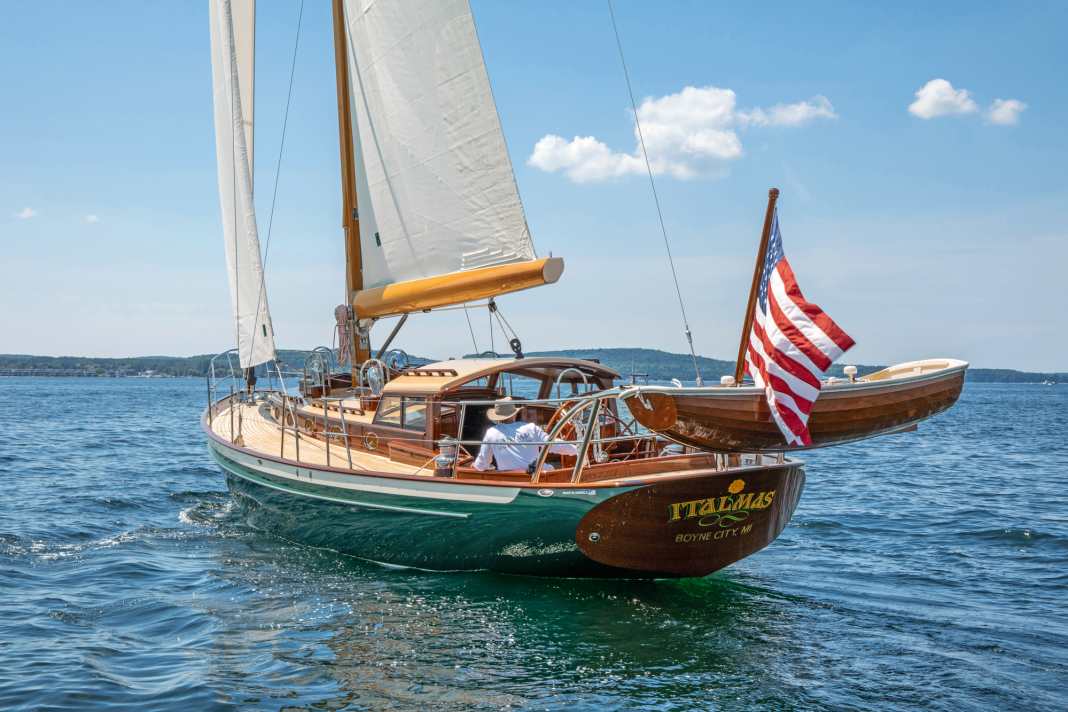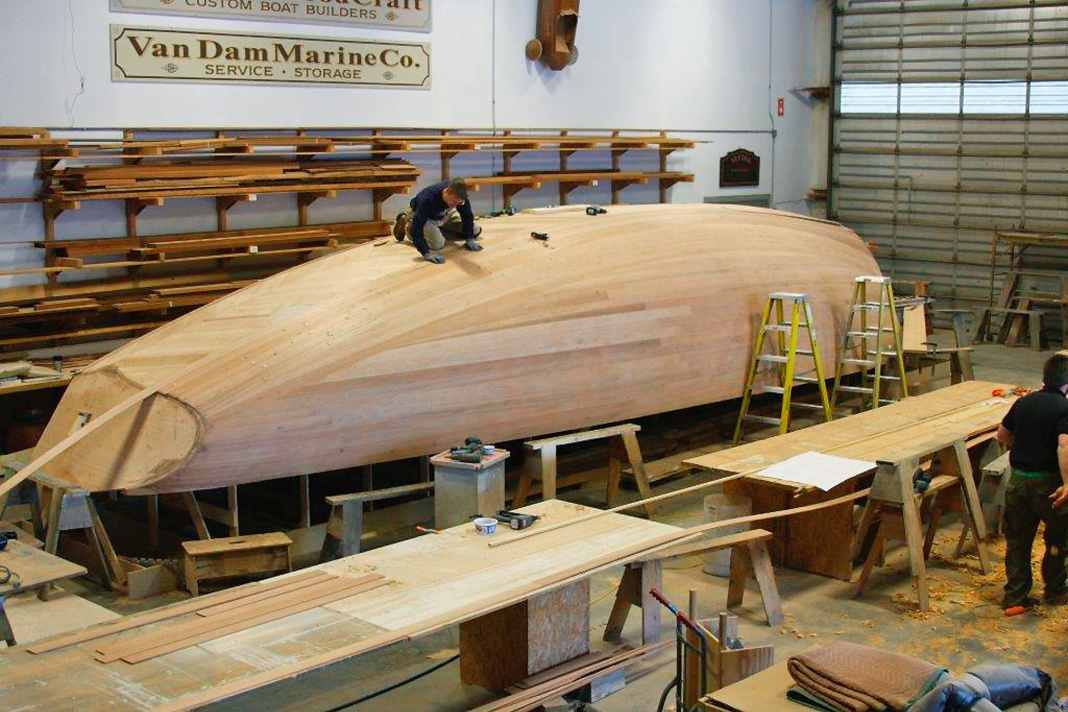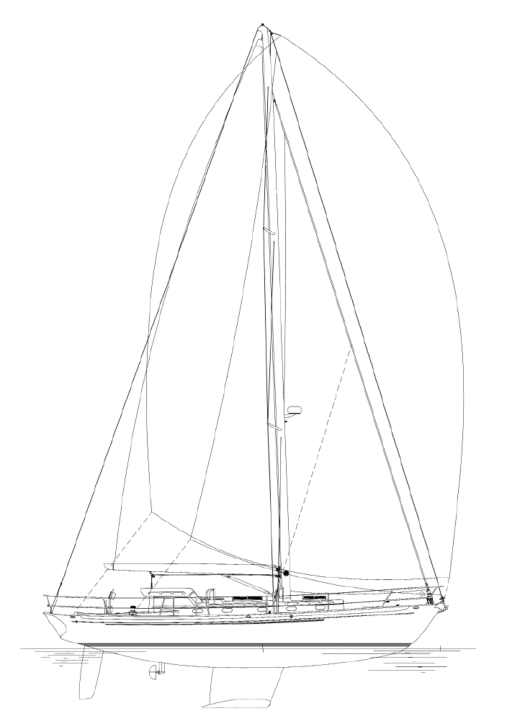





American Bob Grove is in his early 70s, runs his own business supplying metalworking companies and is a man who goes his own way, even if he sometimes has to go against the spirit of the times. After years on production boats such as the Columbia 26 and C&C 33, he matured into a wooden boat connoisseur and now has two beautiful custom-built boats in his private fleet. "I listen to the advice of experts," laughs Grove when asked why he switched from GRP to wood when the trend is going in the opposite direction. The experts he is referring to are right on his doorstep: Van Dam Custom Boats (no relation to Van Dam in Holland), a small shipyard in Boyne City on the southern shore of Lake Charlevoix in the US state of Michigan near the Canadian border that specialises in moulded-glued constructions.
Grove had his "Italmas" built there, which quickly established itself as an eye-catcher with its dark green hull, the reddish mahogany under clear varnish, the shiny chrome fittings and an integrated sprayhood that provides sheltered seating in the cockpit. This noble ship (pronounced It'lmas) is a 13-metre Spirit of Tradition sloop that combines traditional looks with appealing sailing performance, thanks to her split and profiled appendages and 100 square metres of cloth, which are hoisted on a 21-metre high wooden spruce mast.
Troll flower is the inspiration for "Italmas"
Incidentally, the boat was christened by Grove's ex-wife, a professional chef from Udmurtia in Russia, who chose the name of the golden yellow troll flower native to the region, which exudes the scent of honey when in bloom. Grove's other wooden boat, the eleven-metre "Star" sloop, which he bought several years ago from designer Fred Ford, who had the boat built in 1981 at the then up-and-coming Van Dam shipyard, served as a model and source of inspiration for the design of "Italmas".
"I had been talking to shipyard manager Steve Van Dam about a new ship for some time," recalls Grove, who has no thoughts of retirement. Nevertheless, Van Dam advised him to "start soon, otherwise I'll be too old to build and you'll be too old to sail". The keel was laid in 2015, but after the hull was finished, the project was put on hold for three years before Grove allowed the boatbuilders to continue. It sounds simple, but a boutique shipyard with almost two dozen highly skilled craftsmen who build one or two boats a year and produce as many things as possible in-house has to plan for the long term.
"It was an unusual project, partly because Bob is familiar with manufacturing processes and large projects and deals with details that other customers don't even have on their radar," says Ben Van Dam, who was trained at the company and took it over from his parents together with his wife Erika in 2021. "When a customer is so deeply involved, we can also go into more detail, such as making the steel frames for the cabin windows ourselves. As long as we offer better quality and provide practical reasons that make his advantage clear, Bob commissions us with highly interesting projects."
Cruising yacht "Italmas" on Lake Huron
The top priority for "Italmas" was to retain the look of Van Dam's one-off "Star" (green hull, lots of wood and varnish) and her traditional interior layout with engine and storage space under the cockpit, pilot berths on the outside of the saloon benches and an owner's cabin in the foredeck. However, the new, more modern ship sails more nimbly than the long-keel "Star" thanks to the split lateral plan and the generous sail area. Grove can't say when he ties in a reef. "I haven't had to yet," he says, praising the Slup's ability to sail high upwind and fast at the same time.
He also likes the always tidy deck on "Italmas" because the mainsheet and trim lines are led below deck into the cockpit. Of course, a length of 13 metres also offers more space, for example for a larger refrigerator and more work space in the galley as well as for a shower with standing height, but not for everything. This is why you will look in vain for a conventional navigation corner with a seat in the saloon, which is finished in mahogany with a contrasting sole in light-coloured maple and sipo.
That sounds strange for a cruising yacht like "Italmas", especially as the five Great Lakes in the Midwest are among the largest lakes in the world and have a total area equivalent to around ten per cent of the Mediterranean, so there is plenty to do in terms of navigation. But in the age of iPad navigation, Grove has dispensed with a seating area for map work.
He treats himself to four to five weeks of sea time per year, a generous amount of holiday time by US standards, to cruise as far as the North Channel on the Canadian shore of Lake Huron, where he likes to anchor in bays, "even for five nights at a time".
Five layers of wood form the hull shell
Comfort on board was therefore a key consideration for the design, which he commissioned from Stephens Waring Design in Belfast, Maine. "Italmas" was the first joint project with Van Dam, but not uncharted territory. "We have experience in working with specialised shipyards," explains designer Paul Waring. "Van Dam is a very small company that doesn't have its own design office, but in the workshop they really do have all the skills that you would normally expect from a much larger shipyard."
Grove, who proudly says that he has loved rowing his clinker-built Bateka dinghy for two dozen years, is not only a wooden boat lover, but almost a purist, whereas the designers at Stephens Waring Design are material agnostics who design large luxury yachts for any building material. The parties agreed on the cold-moulded method, Van Dam's preferred construction method, where "Italmas" was built from two layers of cold-moulded Sipo mahogany lengthwise and three diagonal layers of red cedar, covered with a layer of fibreglass. Purism or not, in a touch of pragmatism Grove agreed to the GRP coating. "In this case, I relied on the experts. I once crashed into another boat with 'Star' and suffered damage that the shipyard had to repair. If the hull had been clad in GRP, it would have been a different story."
Mix of tried-and-tested and new materials
But with "Italmas", Grove went a little further and accepted the selective use of carbon fibre, for example as a construction material for the rudder and the coker and as reinforcement, for example for the suspension of the fin keel and for the attachment of lever clamps to the mast. Although the boom with integrated furling system also looks like spruce from a distance, it is actually made of carbon fibre, which is hidden under a veneer. "During the construction of 'Italmas', I was sailing on 'Star'," recalls Grove. "Afterwards I called Steve, who had originally recommended a carbon fibre mast, and told him: 'You know, a wooden mast is one of the things I value most on a boat."
Grove also had a teak deck laid, which suits the boat perfectly. Waring does not deny that the political situation in Myanmar raises ecological and human rights concerns. "Nevertheless, teak is still a traditional cornerstone," says Waring. "This wood has been used as decking for more than 100 years because it is ideal for this purpose, creates an elegant non-slip surface and still looks good even when weathered."
"As a designer, you can suggest once or twice that a more sustainable alternative should be chosen," says Waring, but ultimately the customer's wishes are the deciding factor. "It doesn't matter which decking is chosen, whether teak, cedar, Douglas fir or synthetic material, we have to have the right solutions ready."
Slightly longer season for "Italmas"
Many customers who, like Grove, have their boats built at Van Dam also return them there at the end of the relatively short season (June to September) for winterisation and meticulous maintenance. This work is usually carried out by sister company Boyne Boat Yard, which also operates the warehouse. For "Italmas", however, the season can last a little longer, which is partly due to the successful fixed dodger.
This dodger presented us with challenges, which is why I favoured more freeboard to better balance the visual weight of the superstructure," explains Waring. This trick reduces the relative height of the sprayhood "so that it doesn't look like a skyscraper," jokes the designer. Waring also designed a bulwark that tapers from the bow to the stern to accentuate the deck step and conceal part of the cabin superstructure, thereby maintaining the proportions. "The massive dodger was the best idea," enthuses Grove. "Others should copy it. We were anchored in a bay last summer, but we were sitting in the cockpit, well protected, so we could watch a storm coming down around us."
Eye-catcher "Italmas"
Grove, who keeps his two Van Dam boats in immaculate condition, has big plans. "Star", he says, will be specially launched this year for a local wooden boat show to be exhibited together with "Italmas". Afterwards, "Italmas" will move into its heated warehouse, where Van Dam's craftsmen will dismantle the fittings over the coming winter in order to repaint the boat from scratch and maintain its eye-catching status.
"Bob knows his way around construction and sets high standards, including for various details," laughs Van Dam. "One day he turned up at the shipyard and instructed our electrician to lay the cables on 'Italmas' neatly and in parallel. We do that anyway, but a customer with such an obsession for detail suits us well." The final question to Grove is whether he would consider a plastic boat again in the future, which requires less maintenance. "No. For me, there's no going back." And it sounds as if he came to this conclusion on his own this time, without any experts.
Van Dam: Wood with all its soul





The history of the boatyard begins in the 1970s, when Jean and Steve Van Dam got stuck in the Canadian province of Ontario, where Steve took up an apprenticeship with Vic Carpenter, from whom he learnt how to build boats using cold-formed plywood. They then built their own boat, "Feather", a 24-footer with a natural varnished hull, in Harbour Springs and founded Van Dam Custom Boats in 1977. "Silvan", their first order for a larger boat (30-foot cutter), came in 1979, and this vessel is still sailing today.
The Van Dams then expanded their portfolio with five more sailing boats, including "Star" and its successor "Stars Echo", both designed by Fred Ford. Van Dam sold the service and storage business in order to concentrate fully on building high-end wooden boats, but soon reorganised this part of the business into a separate subsidiary (Boyne Boat Yard). At the beginning of 2021, after 44 years on the job, Jean and Steve Van Dam officially retired and sold the company, which is known for its exquisite wooden sailing yachts, including the sand dredger "Tattler" and the 55-foot daysailer "Patrician". Today, however, the focus is on elegant wooden motorboats that would undoubtedly cut a fine figure in Saint-Tropez or on Lake Como.
Technical data of the "Italmas"

- Shipyard:Van Dam
- Construction:Stephen Waring Design
- Material:Mahogany/cedar
- Torso length:13,40 m
- Waterline length:10,70 m
- Width:3,80 m
- Depth:2,00 m
- Weight:10,7 t
- sail area:100 m²
- Engine (Yanmar): 53 PS

